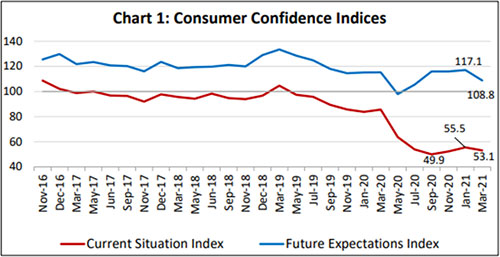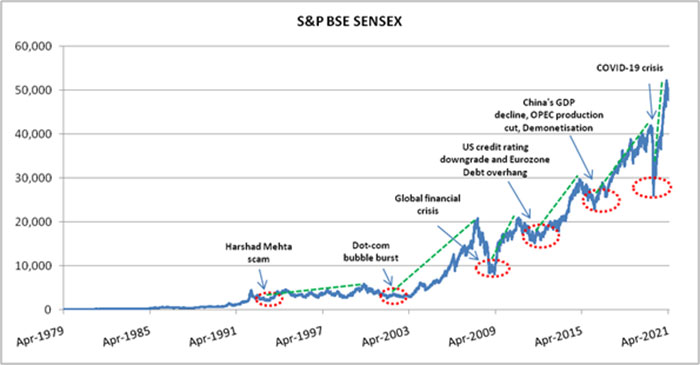Looking to Generate Alpha with Mutual Funds? The Market Volatility amid Second Wave of COVID Can Provide Opportunity
Listen to Looking to Generate Alpha with Mutual Funds? The Market Volatility amid Second Wave of COVID Can Provide Opportunity
00:00
00:00
After weeks of spiralling COVID-19 cases, we have witnessed India become the epicentre of the pandemic. The situation is likely to worsen before it gets better.
Despite this, the central government has shunned the idea of nationwide lockdown to curb the spread of the second wave and has allowed only local containment zones. This is why experts are sticking to double-digit growth estimates for the country during FY 2022 for now.
Some key states in the country, however, have imposed strict restrictions following relentless spread of the virus and overburdening of healthcare infrastructure. A downward revision of GDP forecast, therefore, may be imminent; several high-frequency indicators are already showing signs of a slowdown. India's index of industrial production (IIP) contracted by 3.6% in February while manufacturing activity declined to a 7-month low of 55.4 (PMI index) in March and was largely flat at 55.5 in April due to the renewed COVID restrictions.
Amid the second wave, consumer confidence has hit a low and as a result discretionary spending will continue to witness moderation in the coming months. Therefore, consumption demand, which makes up around 60% of the GDP component, could show adverse growth in the coming months.
Graph 1: Consumer Confidence deteriorates
 (Source: rbi.org.in)
(Source: rbi.org.in)
The impact of the economic challenges may be felt across the GDP growth in the first quarter of FY 2022 and can even extend to the second quarter or beyond depending on how successfully the second wave is contained and successive waves are averted.
The Phase 3 of inoculation drive against the COVID-19 began from May 1 allowing all adults aged 18 and above to be vaccinated is a welcome move. However, given the sheer size of India's population coupled with most states facing vaccine supply crunch, the inoculation drive could be a slow and lengthy process.
As India reels under the dire impact of the second wave of COVID-19, the domestic equity markets have turned volatile again. The S&P BSE Sensex is down around 6.4% from its all-time high of February 16, 2021. Even though the market has not reacted very strongly to reports of second wave, it will continue to be highly volatile with some further consolidation in the near term till the pandemic situation is under control.
That said, the correction in the market from its all-time high is an investment opportunity for long term wealth creation and to generate alpha with equity mutual funds. Historical data suggests that the equity markets bounce back strongly after every major dip. A similar scenario was witnessed last year when the market crashed to multi-year lows due to uncertainties surrounding the pandemic. However, the market not only recovered but also scaled fresh highs across the market cap range.
There have been several such instances in the past where the market witnessed an extended bull run after a volatile phase, take a look at the graph below:
Graph 2: S&P BSE Sensex' sharp rise after every steep fall
 Data as on April 30, 2021
Data as on April 30, 2021
(Source: ACE MF, PersonalFN Research)
Even though the recovery may not be linear and filled with glitches, those who have shown perseverance have gained substantially. Hence, it is important to stay invested in equities for the long term, regardless of volatility, and use any major dip to top-up your investment.
While the second wave of COVID-19 remains a key risk to the economic growth in the short term, over the medium to long term economic growth can be expected to witness strong growth. Here are the factors that can drive economic growth:
-
- Pro-growth measures announced in the Union Budget and COVID relief measures announced by the government such as incentives to manufacturing units, boost to infrastructure, impetus on exports, extension of credit line guarantee scheme, etc.
-
- Monetary and liquidity support from RBI
-
- Vaccination drive may pick pace as new vaccines get approval
-
- Pent-up demand to drive recovery after the second wave subsides
-
- Corporates are adapting to the new normal
Consequently, equity market investors will also benefit immensely when things go back to normalcy. Market correction provides mutual fund managers the opportunity to pick quality stocks at a reasonable price and benefit from its growth potential.
Many large-cap, mid-cap, and small-cap stocks have much scope of delivering superior returns as the economy revives. With this actively managed mutual fund will be well-placed to generate high alpha for its investors. However, one needs to carefully select diversified equity mutual funds that have the potential to market-beating returns.
Table: Long term growth potential of equity mutual funds
|
Absolute (%) |
CAGR (%) |
| Category Average |
1 Year |
3 Years |
5 Years |
7 Years |
| Flexi Cap Fund |
50.49 |
10.81 |
14.53 |
15.55 |
| Large & Mid Cap |
56.16 |
10.12 |
15.05 |
16.63 |
| Large Cap Fund |
45.81 |
10.53 |
13.60 |
14.23 |
| Mid Cap Fund |
69.41 |
10.58 |
15.85 |
18.84 |
| Multi Cap Fund |
59.44 |
11.22 |
14.91 |
16.56 |
| Small cap Fund |
94.01 |
9.33 |
16.32 |
20.04 |
| Value Fund |
60.52 |
6.97 |
13.55 |
15.82 |
Data as on April 30, 2021
(Source: ACE MF, PersonalFN Research)
The table above shows the average returns clocked by the respective equity mutual fund category during various time frames. Equity funds may underperform in the short run due to unfavourable market/macro-economic conditions though they can suitably reward investors who choose to stay invested for a longer period.
While past performance is not an indicator of future returns, it shows the alpha-generating potential of equity mutual funds. Depending on your risk appetite and investment objectives you can create a well-diversified portfolio consisting of Large-cap Funds, Mid-cap Funds, Multi-cap/Flexi-cap Funds, Large & Midcap Funds, Value Funds, etc. But remember that selecting a not so worthy fund or choosing a scheme based by relying solely on the recent performance can cost you dearly.
[Read: How You Can Protect Your Portfolio from Downside Risk amid the Second Wave of Covid-19]
So instead of chasing returns, a better approach will be to invest in schemes with steady performance regardless of market conditions.
Though there is no harm in analysing a fund's past performance, it should not be the only deciding factor for investment. The fund must be able to reward investors by undertaking reasonable level of risk consistent with its investment style and strategy. Remember that the true essence of alpha is to generate 'extra return without taking extra risk'.
Furthermore, you should be looking at the portfolio characteristics of the scheme to assess its ability to generate reliable returns by analysing the following:
Invest in schemes of fund houses that have a reliable performance record and follow robust investment processes with adequate risk management systems in place. The ability of a fund to generate alpha depends on the expertise and ability of the fund manager in taking the right call at the right time and reward investors, irrespective of the market movement. Therefore, it makes sense to check the experience and qualification of the fund manager as well as the track record of schemes they manage.
Once you have identified a worthy fund to invest in based on the above-mentioned parameters, opt for the SIP route to mitigate the impact of volatility on your portfolio. Finally, since equity investments take time to grow and generate meaningful returns, ensure that you have a long term investment horizon of at least 5-7 years.
PS: Here's a high potential opportunity that can multiply your wealth. Get access PersonalFN's high-return generating Alpha Funds Report 2021 that could potentially boost your portfolio returns significantly over the next few years.
PersonalFN's research team has developed a 'SMART Alpha Score' model that has additional parameters to select the top equity mutual funds.

With optimum weightage to each parameter, which we consider important in identifying fundamentally strong funds with the potential to generate alpha, this model helps zero in on quality names that have the ability to outperform the benchmark and generate alpha returns for its long term investors.
Subscribe to The Alpha Funds Report -2021 today!
Warm Regards,
Divya Grover
Research Analyst
Join Now: PersonalFN is now on Telegram. Join FREE Today to get 'Daily Wealth Letter' and Exclusive Updates on Mutual Funds